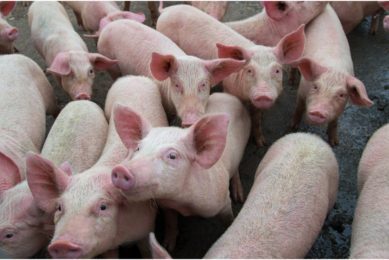Fatty acids – the new frontier in pig nutrition

Fatty acids are feed components that are gaining more and more importance. There is a lot that needs further study. For instance, what do we know about the ideal ratio of omega-6 and omega-3 fatty acids for pig feed?
The applied scientists working in the field of pig nutrition have been very successful in teasing out the detail of carbohydrate utilisation in pigs via the characterisation of carbohydrates and the role of feed processing and enzyme technology to achieve efficient energy extraction.
Ideal protein concept
Similarly in the field of protein nutrition the development of the ‘ideal protein’ concept and the quantitation of the standardised ileal digestible amino acid content of feedstuffs have allowed precise use of protein resources supported by effective synthetic amino acid supplementation to meet the needs of animals in each stage of production.
On the mineral and vitamin front there have been considerable advances in our understanding of mineral availability and interactions, and the role of organic minerals in meeting requirements as well as the documentation of vitamin responses which allow appropriate risk management or insurance policies to be applied.
Fatty acids emerging to become significant
An area of pig nutrition that has previously sat quietly in the background, and is now emerging to be very significant, is that of the role of fatty acids. Traditionally fat and oils have been viewed as energy dense components that can be used to manipulate the energy density of diets.
Differences between the various sources in terms of fatty acid profiles, the degree of saturation of the fatty acids, chain length of the various fatty acid, effects of this on digestibility, risk of oxidative rancidity, palatability, pellet quality, mash flow ability, etc. have long been recognised but have not assumed the significance of recent findings of the influence of specific fatty acids on metabolic processes and the health/ performance of the animals.
The role of essential fatty acids
Although the role of ‘essential’ fatty acids has long been recognised, their role has been rather vaguely described and their prominence in dietary specifications has been relatively minor as reflected in the NRC published requirements for pigs.
Recent research in the USA has highlighted the significance of linoleic and linolenic acids in the reproductive performance of sows.
The authors suggest that reproduction may be optimised at levels of 3.3% linoleic and 0.45% linolenic acid in the diet, yet diets applied in other parts of the world which result in excellent reproductive performance (Europe, Australia) involve much lower levels of these fatty acids. Hence there would appear to be more to the story then just meeting a certain level in the diet or the absolute levels of each ingested per day.
Australian trials with weaners and sows
Recent research in Australia where weaners and gestating sows were fed common diets with the exception of the fat source (comparison of tallow, fish oil, and safflower oil) creating a range in the final omega-6: omega-3 (ω-6: ω-3) ratio in the diet of 5 to 30, resulted in profound differences in performance.
In the weaners the high ω-6: ω-3 ratio (safflower oil) resulted in a marked depression of feed intake and subsequent growth. In the pregnant sows the high ω-6: ω-3 ratio resulted in reduced numbers born alive largely due to elevated still birth and mummy rates. It has been speculated that these negative effects of the elevated ω-6: ω-3 ratio may be associated with an immune system disturbance.
Linoleic acid (ω-6) is a precursor to arachidonic acid and ultimately pro-inflammatory cytokines while linolenic acid (ω-3) is a precursor to EPA and DHA and ultimately anti-inflammatory cytokines.
There is a perception that there may be a form of Yin: Yang balance between these with a disturbance having serious consequences.
Fish oil supplementation
Parallel evidence has emerged of the benefits of fish oil supplementation (high ω-3) on reproductive performance in breeders and improved anti-inflammatory/ immune competence aspects in weaners (which essentially involves a lowering of the ω-6: ω-3 ratio).
The evidence to date suggests that a ω-6: ω-3 ratio of less than 10 and probably closer to 5 is optimal. A rework of the US data in sows suggests the responses could be equally interpreted in terms of the ω-6: ω-3 ratio as much as the absolute amounts of each fatty acid.
Although many nutritionists are now formulating to ω-6: ω-3 ratios, questions still remain as to the efficiency of linolenic acid as an ω-3 source relative to the longer chain EPA and DHA in fish oils. Grouping them together into a common ω-3 pool may be too simplistic and may not allow an accurate description of the ω-6: functional ω-3 ratio.
Unexpected changes in ω-6: ω-3 ratio
Our ignorance of the consequences of a shift in the ω-6: ω-3 ratio could well explain the unexpected changes in performance as new formulations, apparently to the same basic specs, have been applied in commercial production.
We have much to learn in this field and I look forward with anticipation to further research in this area.











